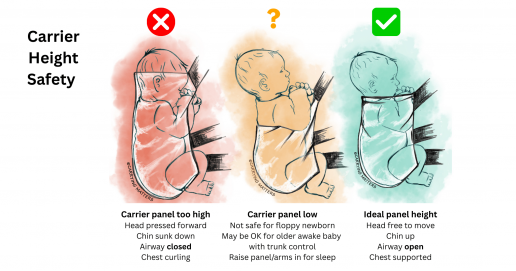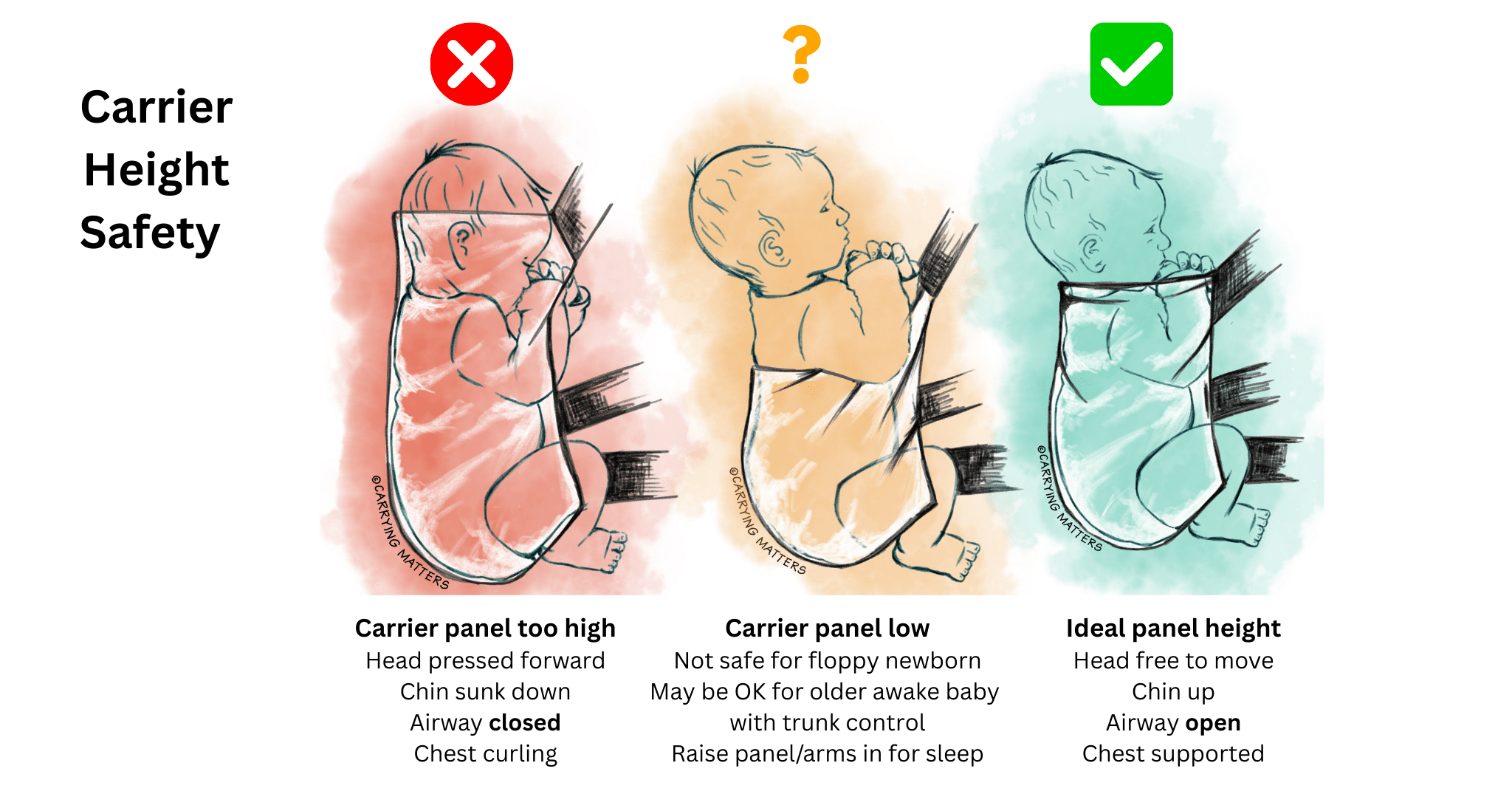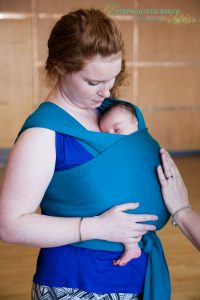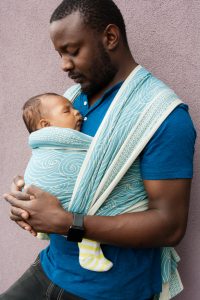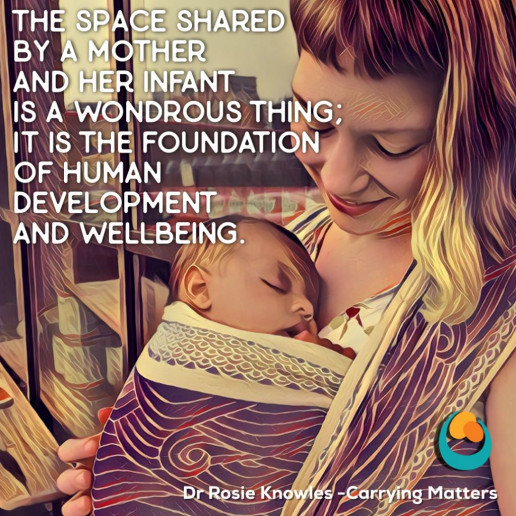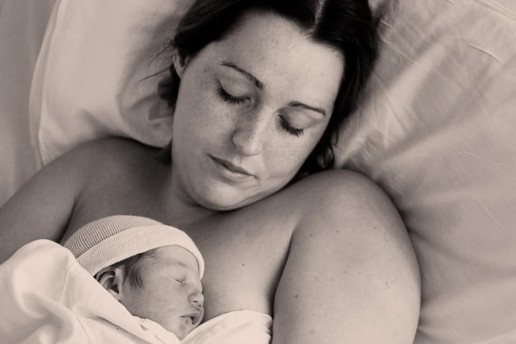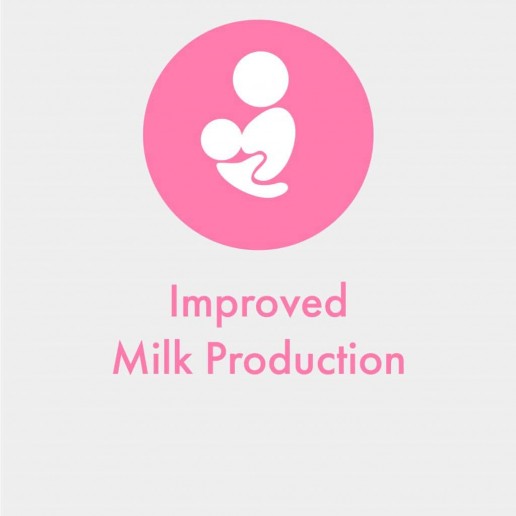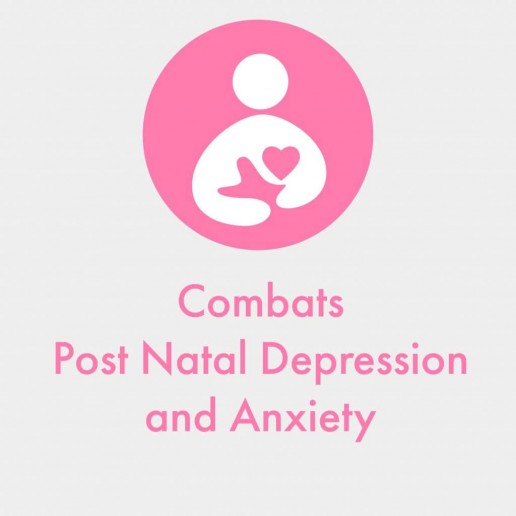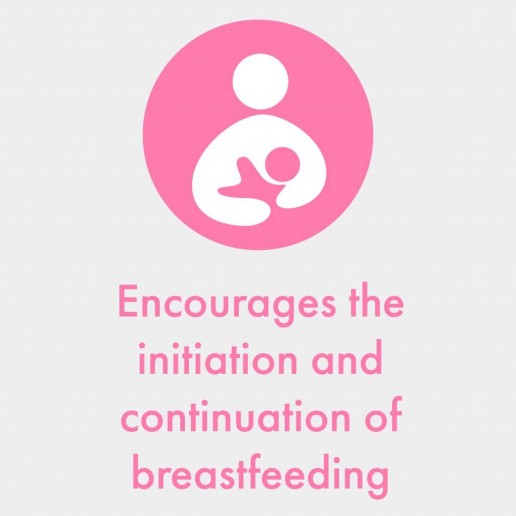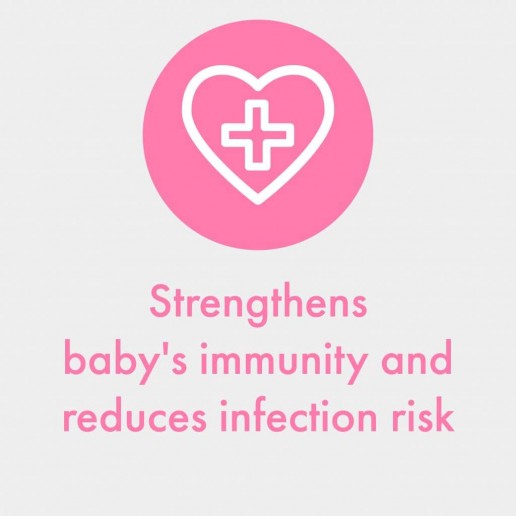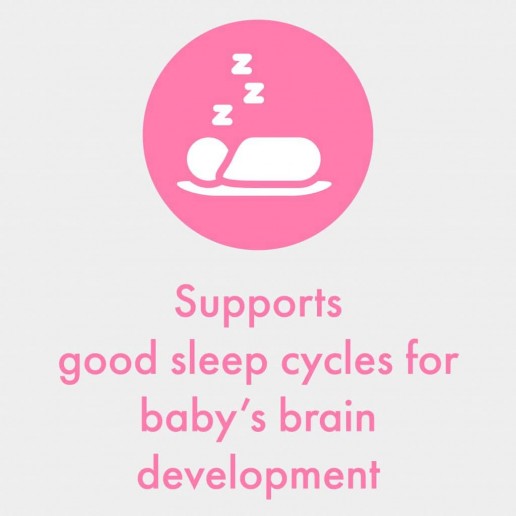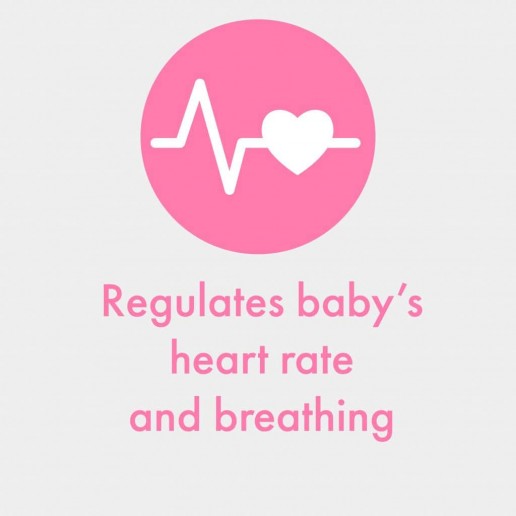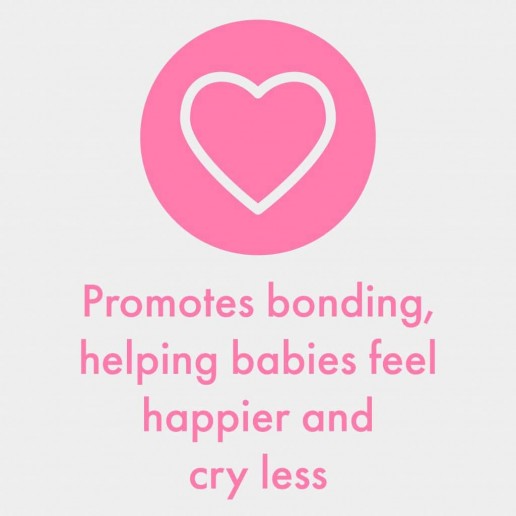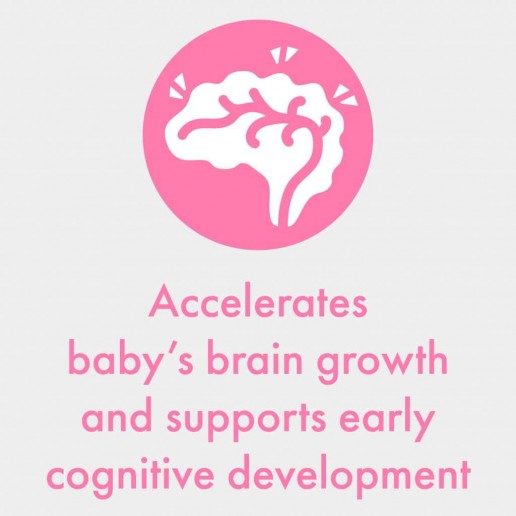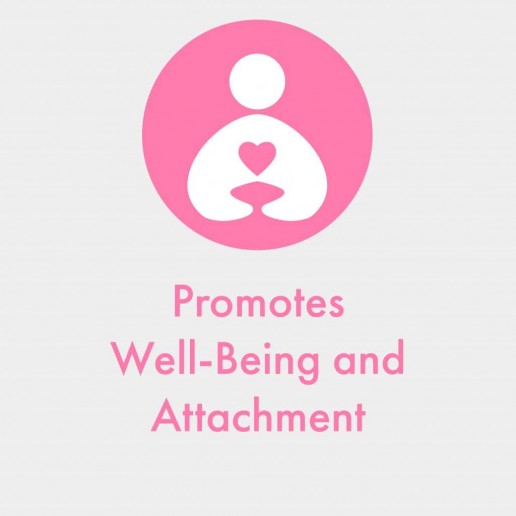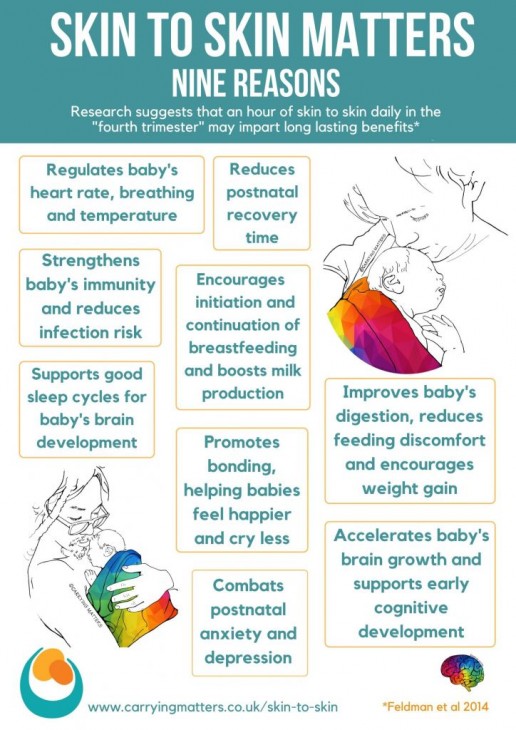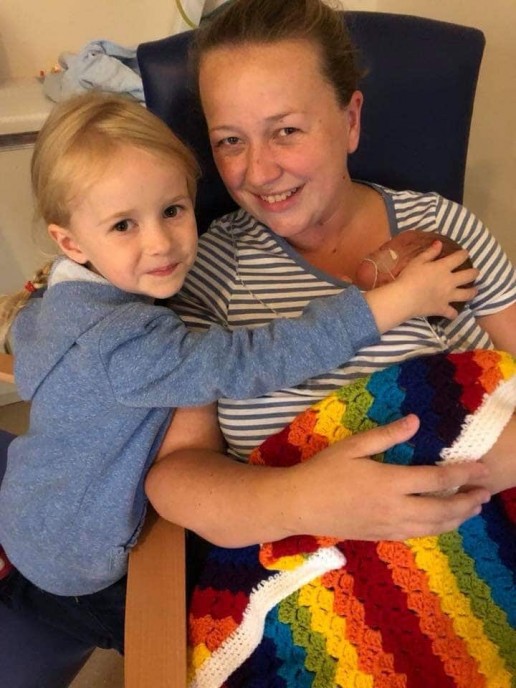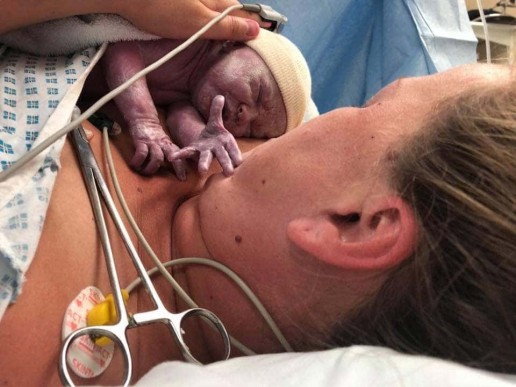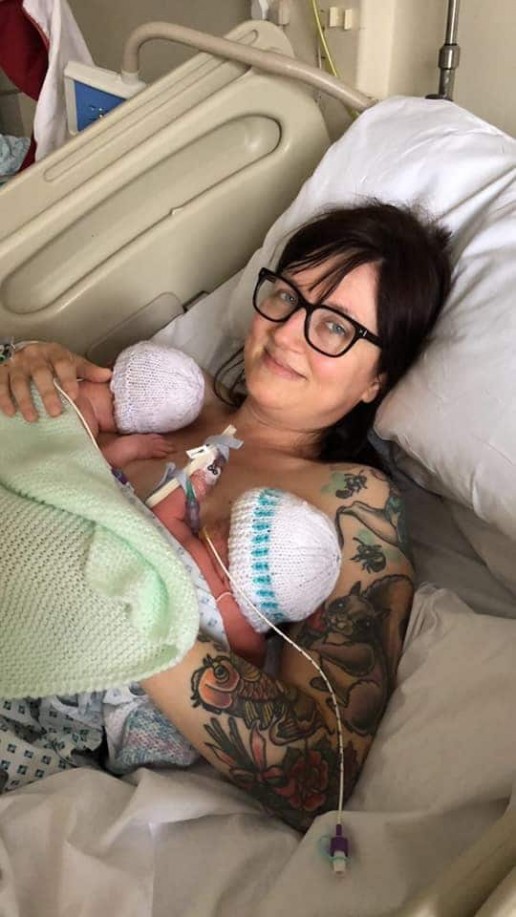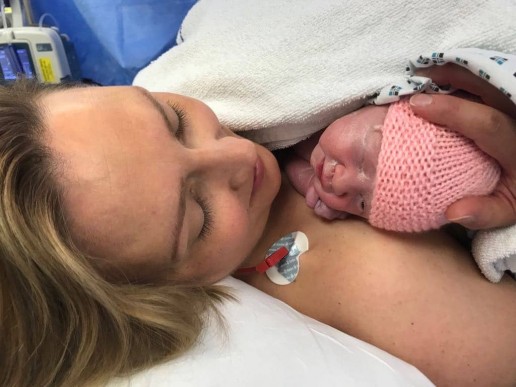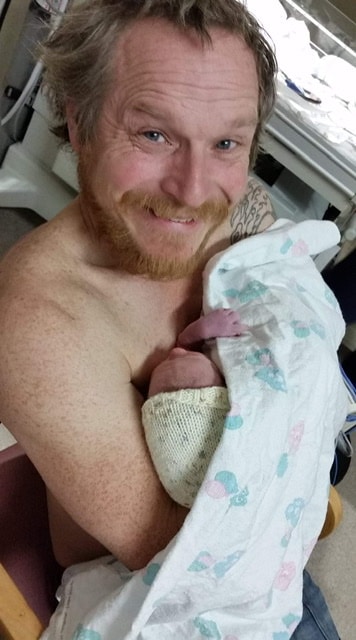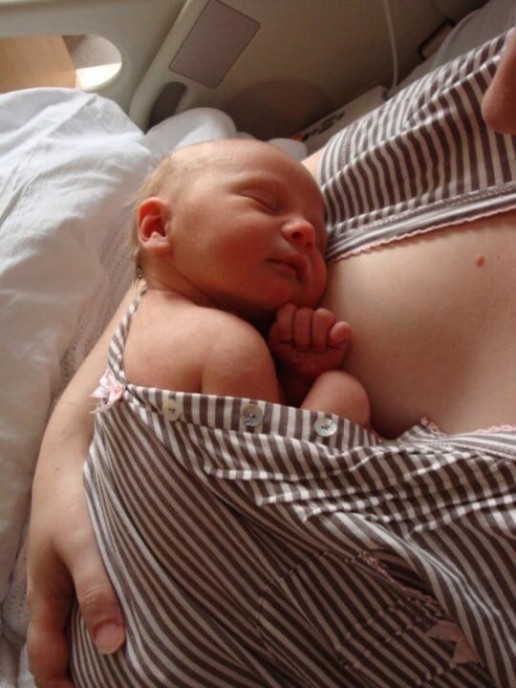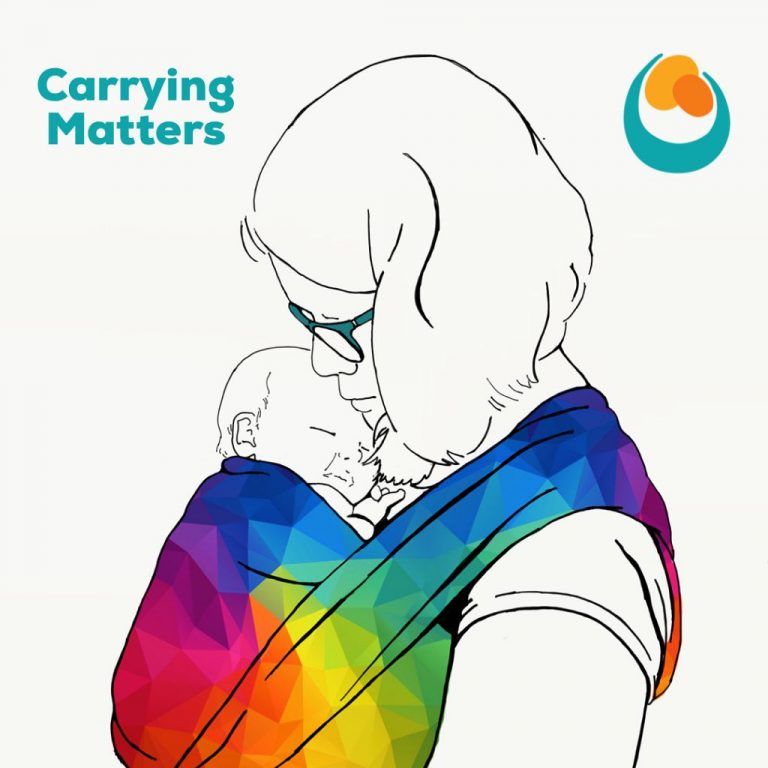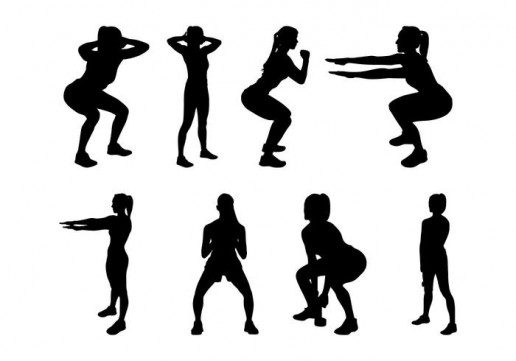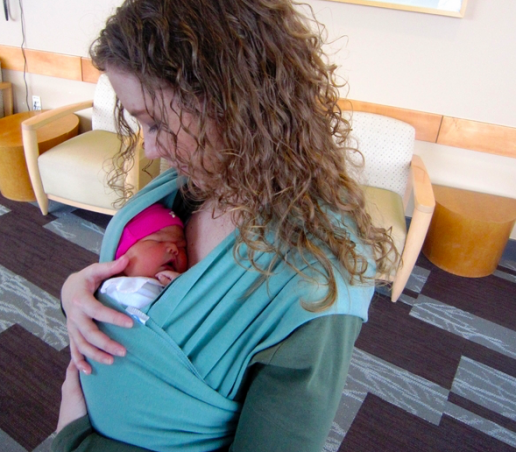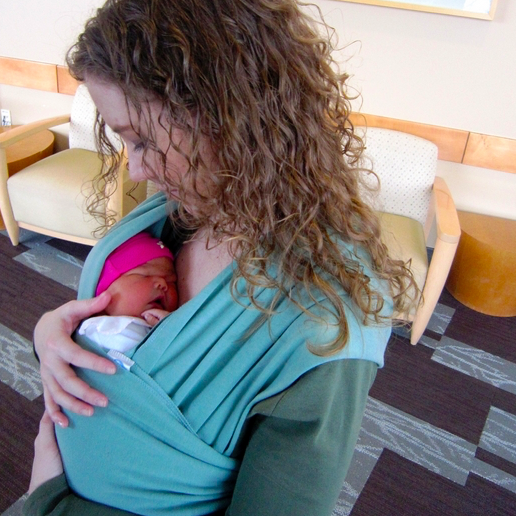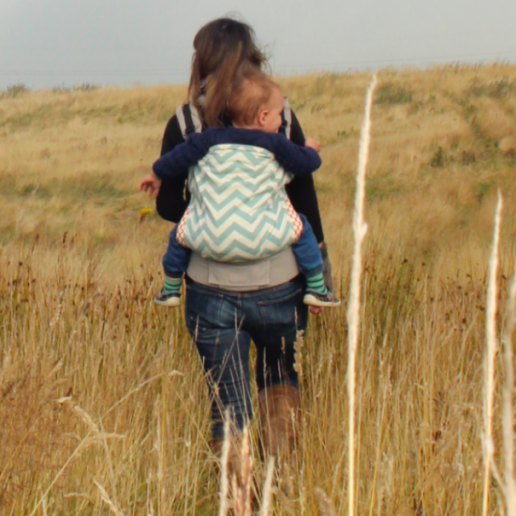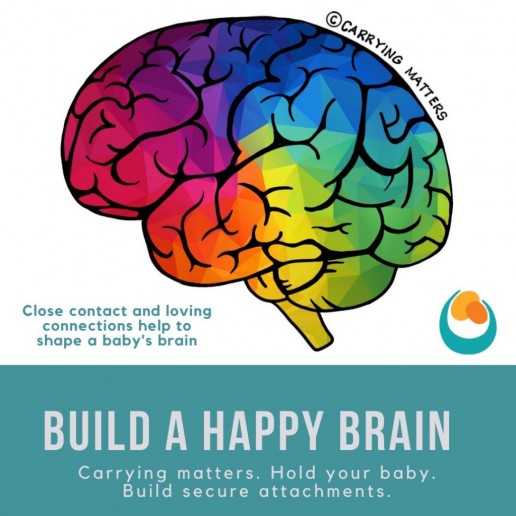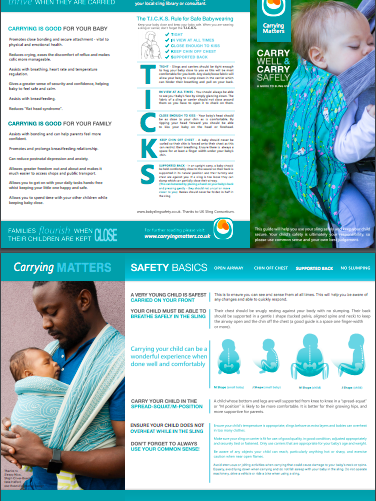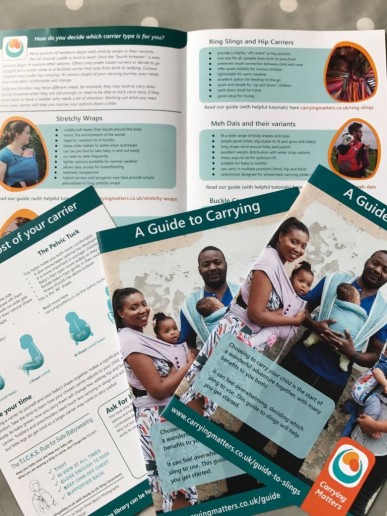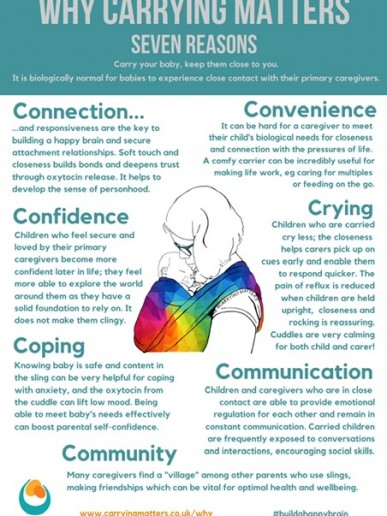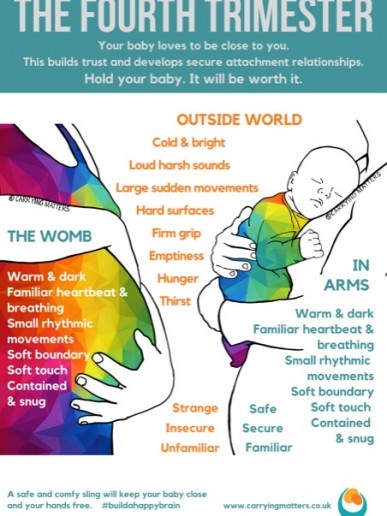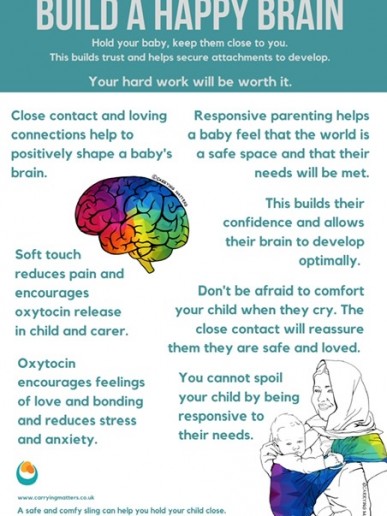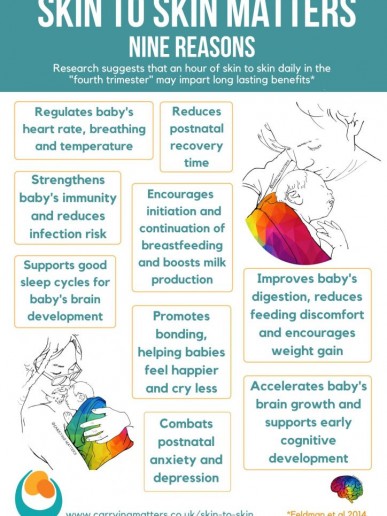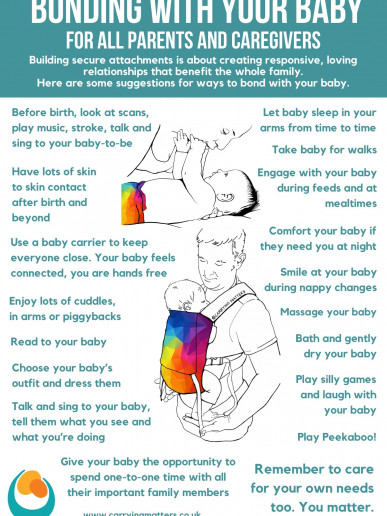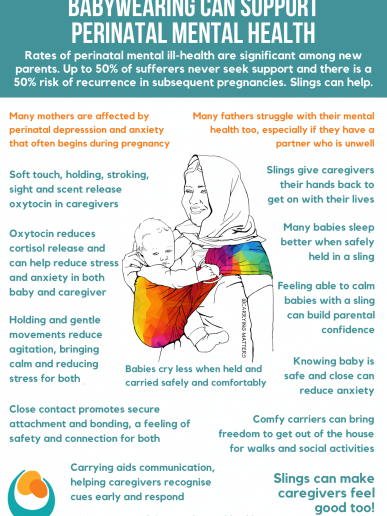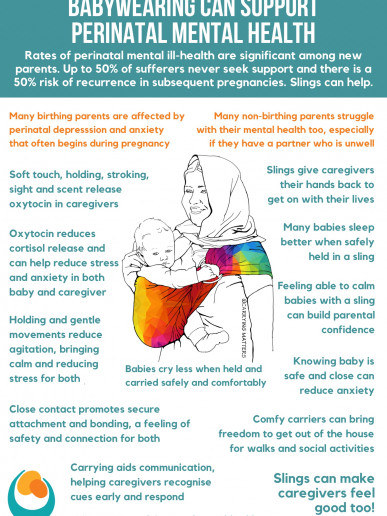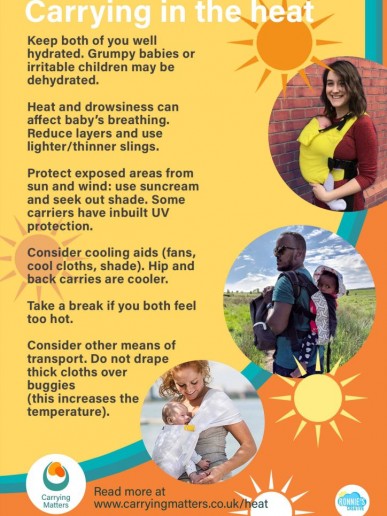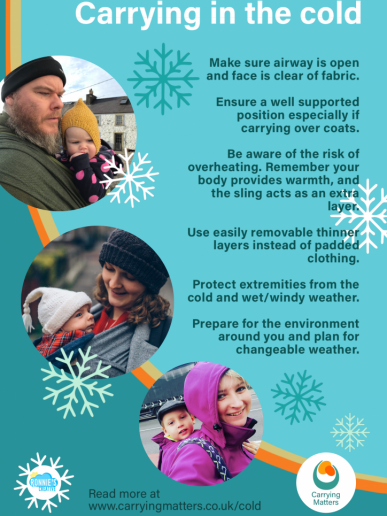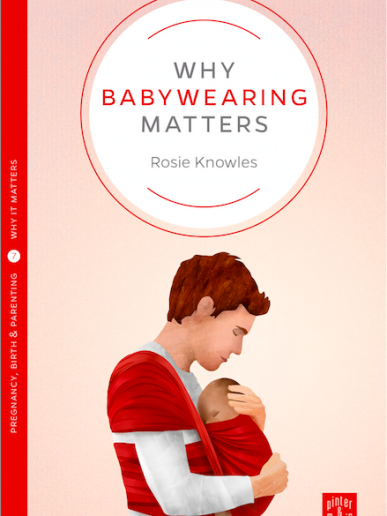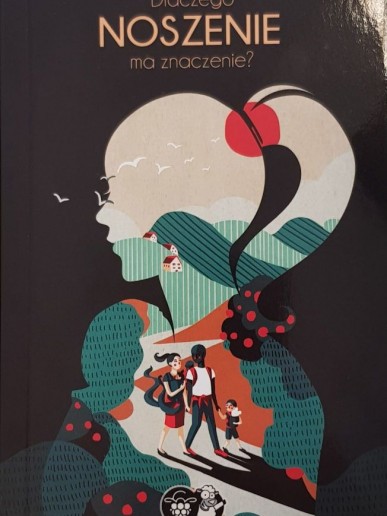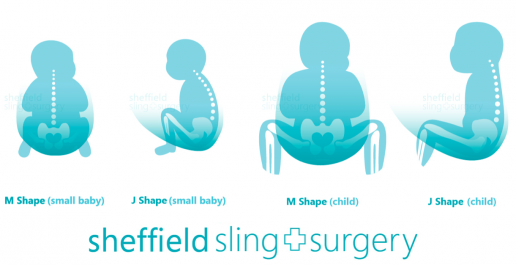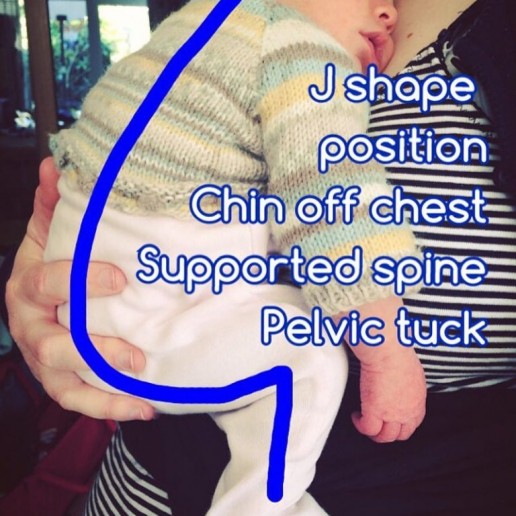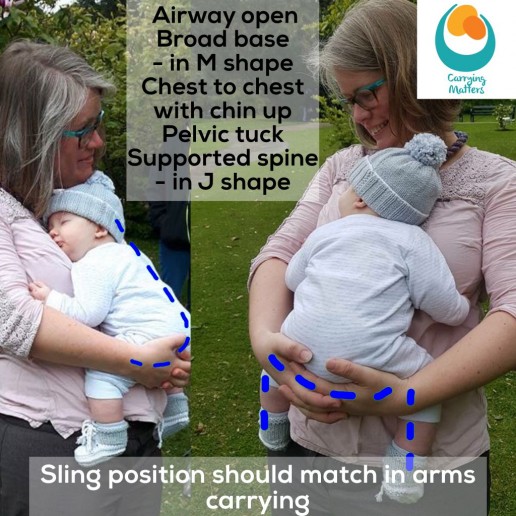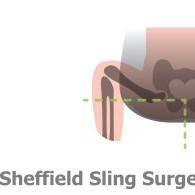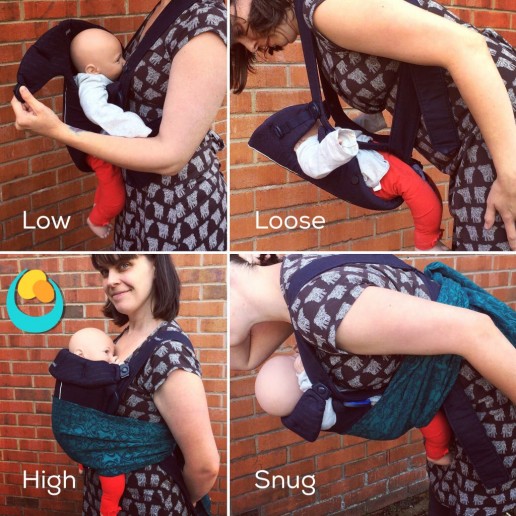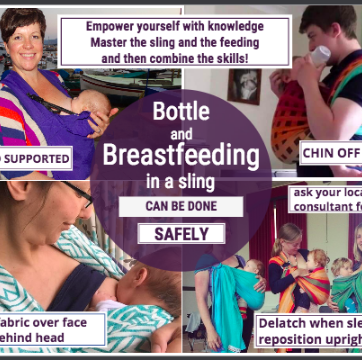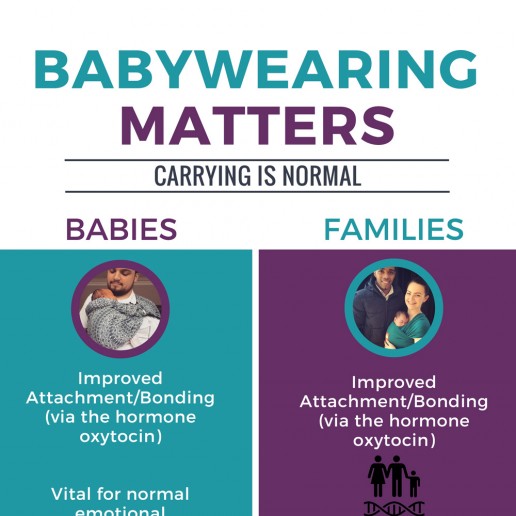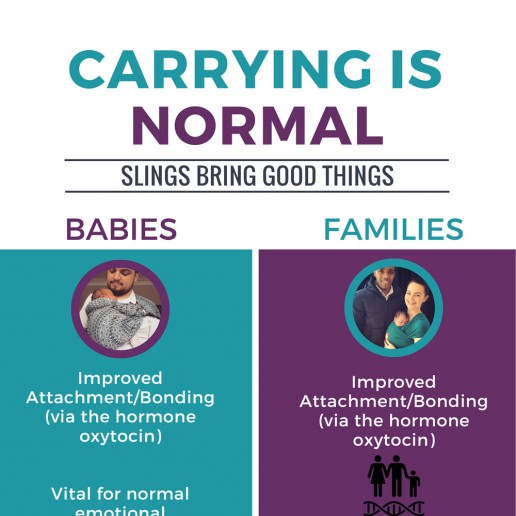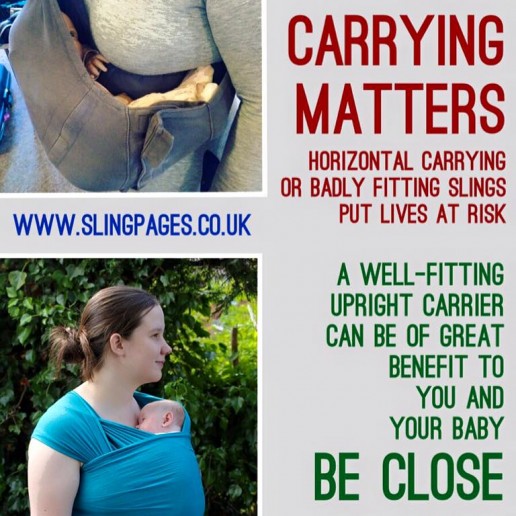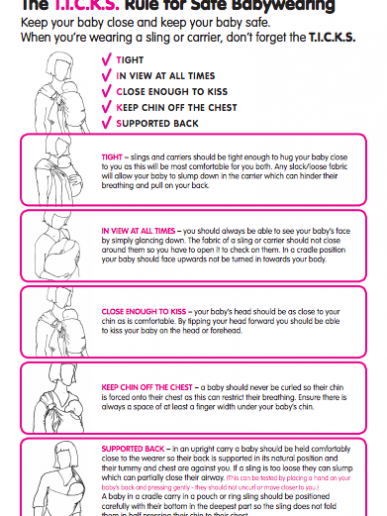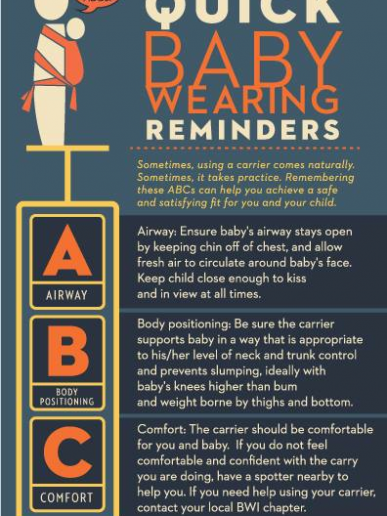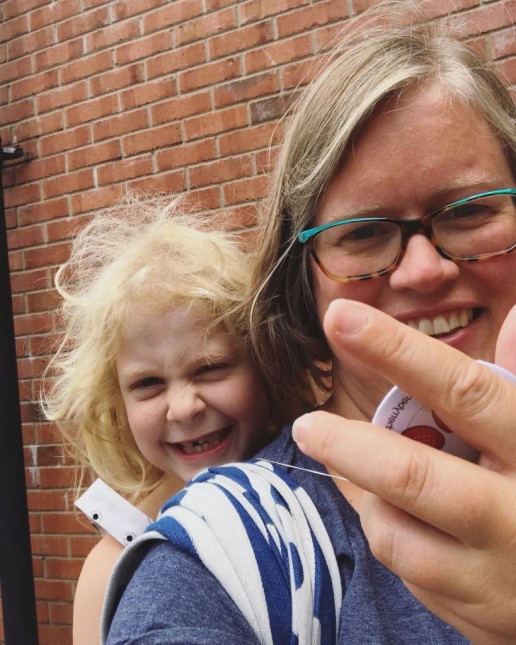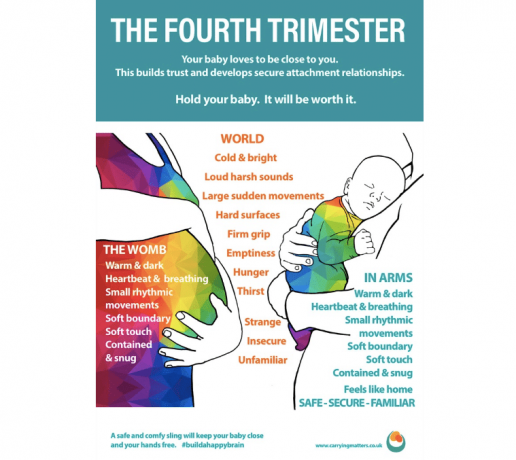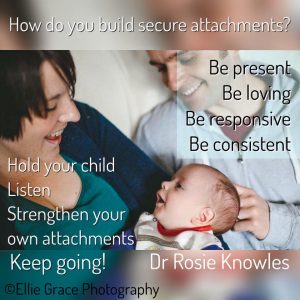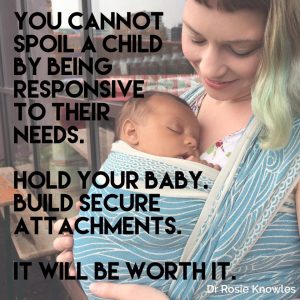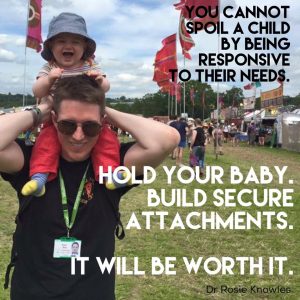Safe Carrier Height
Safe Height of Baby Carriers
It is very important to ensure babies' airways are unobstructed at all times in all types of carrier, at all ages. This is of particular concern for young and small babies due to their anatomical considerations and their vulnerability, as well as their tendency to fall asleep when feeling warm and safe.
Babies are born with large, heavy heads with a prominent occipital curve (the solid bone at the back). This is more pronounced in babies than in older children and adults, and is often known as "nature's pillow". They also have large tongues and short necks, which makes it easier for their airway to become compressed and lost, making it hard for them to breathe.
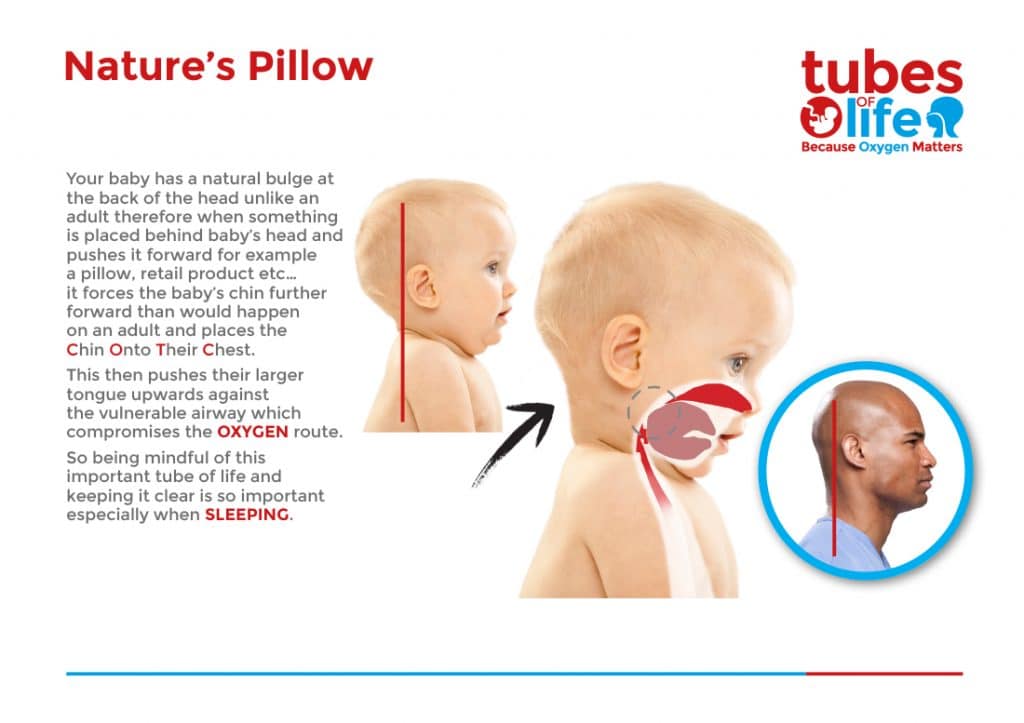
With this information we can now look at the impact of carrier heights. Many manufacturers emphasise a tall panel as offering "head and neck support", however this misunderstanding of baby anatomy with a focus on marketing can cause significant problems.
The traffic image below shows three carrier heights.
The red image with the cross symbol shows the impact of having a carrier that is too high for baby, or one that is too loose that baby can slump forward and sink down into. Baby's head has been pressed forward by the panel height, so their chin has sunk onto their chest. Their airway is compromised and they are at risk. This baby needs to be taken out of the carrier so they can breathe safely. The carrier should be adjusted to the appropriate height, or not used until baby is big enough. When babies sleep, their muscle tone relaxes, so they may slump into carriers that have become too loose from their active weight. If baby is starting to fall asleep, the carrier must be adjusted to ensure it is snug enough around them so they do not sink downward and end up with their head pressed forward by the carrier, and losing their airway.
The green image with the tick symbol shows the optimum panel height. The carrier is reaching to the nape of the neck and earlobes are visible. The baby's head is free to move from side to side and back and forth with no restrictions. Baby's chin is off the chest and airway is open for easy breathing. The chest is well supported against the parent/carer so baby cannot slump into a curved C shape, even if they fall asleep. If baby does slump with sleep, the carrier needs to be adjusted so it is snug and baby's chest is no longer curling forward.
The orange image with a question mark shows a panel that is low. This is not safe for a newborn, or a younger baby who lacks trunk and neck control, or one who is sleeping. They may fall backwards as there is inadequate support for their upper back. The panel will need to be adjusted to be long enough, reaching only to the nape of the neck. An older, awake baby may enjoy having arms out of the carrier for better visibility and engagement with the world. However they must have adequate trunk and neck support. In general, if a parent is able to perch their baby on their hip and support them confidently with one arm, that baby can be worn with arms out. As soon as they are showing signs of sleepiness, their arms need to be brought in and carrier adjusted to reach the nape of the neck for support, and to be snug around baby so they cannot slump.
What if my baby's head is floppy?
Parents often worry about a baby having a floppy head in the newborn stage and it is natural to feel the need to support baby's head. One hand to provide support when you lean forward or walk may be all you need, and babies will soon develop strength and co-ordination. The key thing for airway safety is to avoid forward slumping in a too-loose carrier. Looseness can cause wobbly heads, more importantly it can allow babies to slide and slump, so please check your carrier tension/fit and do not be tempted to raise the panel. Please visit your local library for support if you are struggling, we are all experienced at working with this issue and would be delighted to help.
Some people like to use the sides of a stretchy or woven wrap to provide gentle support to the back of baby's head while asleep, as in the image below.
This can be helpful if their face remains free of fabric on the other side, but it must be done with caution and alertness to any sinking of the head, or baby wishing to change the direction of their face. I usually recommend flipping the fabric to ensure a good line of tension to help with support, and ensuring an open airflow on both sides.
Some people will use a rolled muslin or teatowel tucked into the horizontal layer. If you do this please ensure it is a narrow roll to avoid inadvertently tipping the occipital bone forwards. The image below shows how the roll remains at the nape of the neck and the fabric is rolled outward so the muslin cannot accidentally fall inside the space occupied by baby. Chin is up and airway is open. This is not usually necessary if the carrier is snug across baby's upper back and they have a good pelvic tuck. Please see this link for more reading about the pelvic tuck.
What about buckle carriers whose panel is too long?
Some carriers have adjustable panels, which will help. For those that don’t, this is a challenge. Here is a video showing you how to raise baby inside a panel that is too tall (Ergobaby Omni 360 here). Do not be tempted to leave the panel too tall. See your local Iibrary if you are struggling, or wait till your baby has grown taller and the carrier now fits. Here is a photo tutorial showing you how to raise your baby inside a panel that is too long, if it cannot be adjusted.
My baby likes to face-plant!
This is not uncommon. Ensure good airflow on both sides of the face by flipping the shoulders of wraps and ensuring panel height is not too high up the sides. More reading here.
What if my baby has fallen asleep in the carrier on my back?
This can cause babies to feel loose and floppy and their head can fall backwards. This can often be rectified by adjusting their position and the snugness of the carrier. Children often loosen carriers by moving happily when awake, parents must be aware of this tendency and willing to adjust the carrier so airway is maintained at all times. See here for how to do this.
Facing out
Forward facing out brings its own challenges for an airway. Carriers that are too tall will cause pressure on baby's tender neck when facing out. This is especially risky if they fall asleep and their head falls forward with their neck compressed by the carrier rim. It is not safe for a baby to sleep facing forwards. Sleeping babies must be removed from the forward facing out position and turned around for safe sleep. Please see this link for further reading.
Feeding in carriers
Feeding in carriers must be done safely. For the above reasons, there should never be any fabric behind baby's head when breastfeeding, as their nose could also become blocked by breast tissue. Once the feed is over, baby must be removed or repositioned at an appropriate height on the hard upper part of the chest. Babies should not be left to sleep in a feeding position/height. Please see this link for further reading.
_________________
Link to image for sharing (and other resources) here.
The importance of soft touch for healthy infant development
A huge amount of work has been done in recent years to understand the role of soft touch in how babies' brains develop. Here I summarise the major points in one page! It has been a great privilege to visit the Affective Touch conference in Liverpool and all the ACE-Aware Nation events in Scotland (with Nadine Burke-Harris and Gabor Mate) and to see all this research coming together.
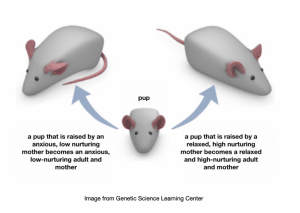
- it switches certain genes on and off, thus affecting cortisol receptor expression and therefore modulates the stress response. This was shown by Michael Meaney and his team; rat pups who were licked and groomed frequently by their mothers became high-licking mothers themselves. The DNA methylation of these high-licking rats and their offspring were different from low-licking rats. When a pup from a low-licking mother was fostered in a high-licking nest, this pup became a high-licker, and was found to display the same DNA changes. Behaviour had altered the expression of these genes, and these epigenetic changes persisted into the offspring.
- Soft touch reduces anxiety and pain, thought to be via effects on the HPA axis, parasympathetic system and oxytocin release.
- Deep pressure (as in hugs and massage) is also thought to play an important part in social touch, activating brain regions highly similar to those that respond to C-tactile stroking.
- Neonatal studies have shown the impact of soft touch (skin to skin) on improving long term neurodevelopmental outcomes, as they are thought provide a scaffold for the developing social brain.
- Soft touch and holding is know to help with regulating and stabilising cardiovascular parameters in premature babies and a good case for babywearing as a positive intervention has been made in a study in one NICU.
- There are positive long- term effects of supporting early mother-baby close contact. The "Family Nurture Intervention" studies suggest that at age 4-5, the intervention arm showed more healthy autonomic regulation
Soft touch also affects the hormonal systems of the body.
- Oxytocin is well known to be released by skin to skin tactile contact, as well as visual, auditory, olfactory stimuli, and works to promote further social interaction. Close contact stimulates release of this important hormone of bonding into both halves of the dyad (usually mother and baby).
- Oxytocin reduces stress and increases a sense of wellbeing and connection, and it has been proposed that regular skin to skin contact can shift the overall balance of the neurohumoral system away from sympathetic activation (stress, flight/fight) towards the parasympathetic/oxytocinergic system (calm and connection). With what we know about the effects of prolonged stress and cortisol release on health, this is encouraging.
It is clear that there are major benefits to the frontal closeness that babywearing in the early months and years can bring!
Further reading
Epigenetic programming by maternal behavior, Nature Neuroscience volume 7, pages 847–854(2004) Meaney et al
C-Tactile Afferents: Cutaneous mediators of oxytocin release during affiliative tactile interactions? Neuropeptides, Volume 64, August 2017, Walker et al
Pleasant Deep Pressure: Expanding the Social Touch Hypothesis Neuroscience, Aug 2020, Case et al
The Dual Nature of Early-Life Experience on Somatosensory Processing in the Human Infant Brain, Current Biology Vol 27 Issue 7, P1048-1054 Maitre et al
Babywearing as an intervention in the NICU Advances in Neonatal Care: September 29, 2020, Williams et al
Longer term effects of nurture on mother/child regulation Clin Neurophysiol Off J Int Fed Clin Neurophysiol. 2014;125(4):675-684, Welch et al
Why Oxytocin Matters, Kerstin Uvnas-Moberg, 2020
Neuroendocrine mechanisms involved in the physiological effects caused by skin-to-skin contact. Infant Behavior and Development, Volume 61, November 2020, Uvnas-Moberg et al
Top FAQS
These are the most common questions about babywearing I am asked, in a single helpful list!
Just click on the links to read the relevant blog posts, some are kindly shared from others
Firstly; some of my most popular articles:
Do the babywearing “rules” really matter?
Babywearing and infant mental health
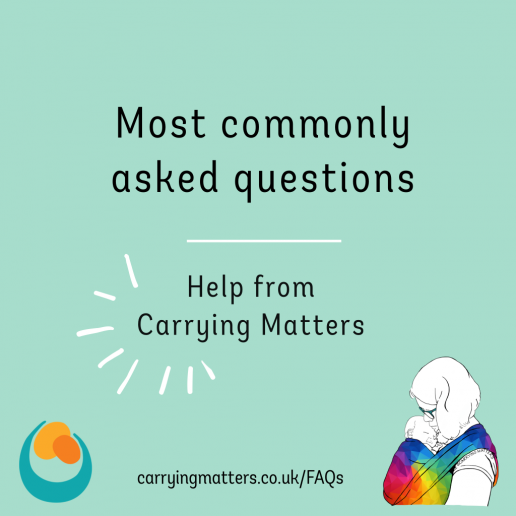
Secondly, I get this query daily. “Can I use your infographics to support families?” ABSOLUTELY! Everything on this website was created to help families with children to feel close and connected. Please credit me appropriately and link back to my website/social media (facebook, instagram)
Here is the link to the infographics (eg the Fourth Trimester/Build a Happy Brain/Why Carrying Matters/Skin to Skin posters, safe carrying images and much more)
Here is a search box to help you find what you’re looking for.
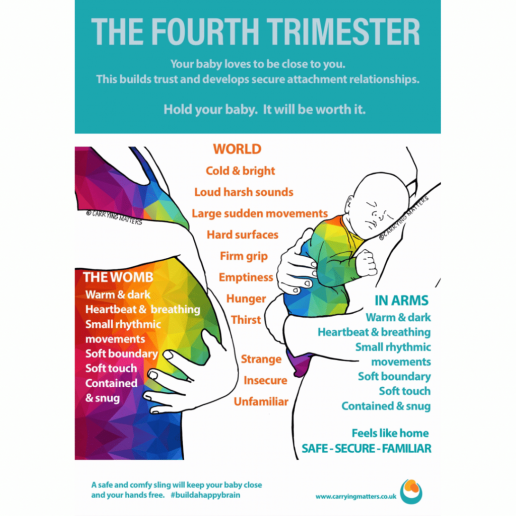
Getting started, and learning the basics
What kinds of sling are there and how do I use them? (links to the major types with useful guides, videos and troubleshooting)
How do I keep my baby safe in the sling?
Babywearing with a Newborn
What are the benefits of babywearing for my baby?
Are there any benefits for me too?
What are the best newborn sling options? (Coming soon)
How soon after birth can I carry my baby and what if I have had a Caesarean Section?
My baby’s head is so wobbly in the sling!
How high should my carrier be?
Can I carry my premature baby?
How do I protect my postnatal pelvic floor and babywear?
What about if I have a prolapse? (Thanks to Forest of Dean Slings)
Help! My child cries in the sling!
Does babywearing help my mental health?
Are slings useful if I have a perinatal mental health challenge?
Carrying in different circumstances
Can I sleep while my baby sleeps in their carrier?
How do I carry more than one child at a time?
How can I carry safely in hot weather?
How do I keep my baby warm while carrying in the cold? (ie can I put them in a snowsuit?)
How do I keep myself and baby dry when babywearing in the rain? (Coming soon)
Carrying adopted or foster children
What if my child has a disability? See this link for a stories from families living with a range of specific conditions.
Common safety queries
Will my sling hurt my baby’s hips?
What if I fall while babywearing? (Coming soon)
Skin to skin contact brings long lasting benefits
Skin to skin contact, also known as "kangaroo care", is one of the simplest yet most effective practices to help babies and their carers make the transition to life as a new family, supporting the development of essential bonds.
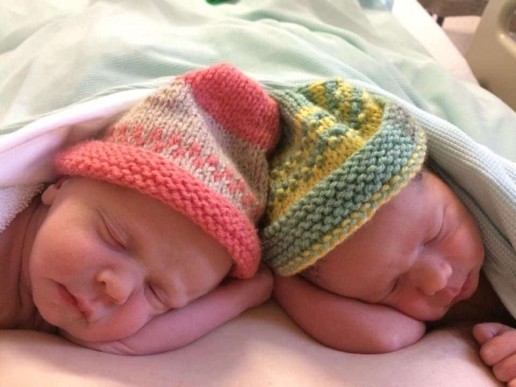
It is a major part of helping the baby to adjust to life outside the womb; the “fourth trimester” concept, and is highly important for supporting mothers to initiate breastfeeding and for carers to develop a close, loving relationship with their baby.
What exactly is skin to skin?
Here is the Unicef definition.
It is usually referred to as the practice where a baby is dried and laid directly on their mother’s bare chest after birth, both of them covered in a warm blanket and left for at least an hour or until after the first feed. Skin-to-skin contact can also take place any time a baby needs comforting or calming and to help boost a mother’s milk supply. Skin-to-skin contact is also vital in neonatal units, where it is often known as ‘kangaroo care’, helping parents to bond with their baby, as well as supporting better physical and developmental outcomes for the baby.
Why does it matter?
Outcomes for babies and their parents are better when kangaroo care is offered, especially with premature or low birthweight infants. A collection of studies examined outcomes for mothers and healthy newborns and concluded that there were clear benefits for physiological development, breastfeeding outcomes, emotional wellbeing. Other studies are helpfully summarised here, showing enhanced bonding and attachment, and likely a direct impact on infant development by contributing to neurophysiological organisation and an indirect effect by improving parental mood, perceptions, and interactive behaviour.
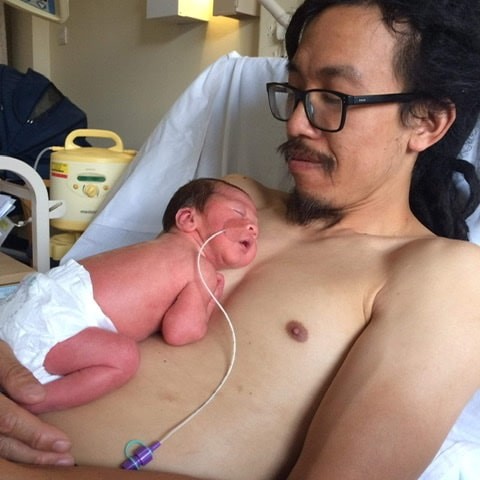
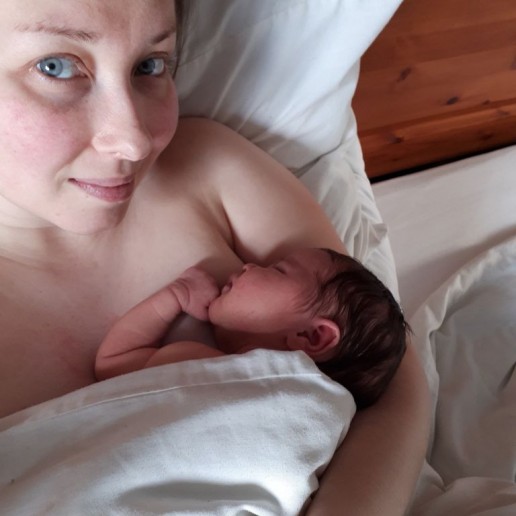
The major benefits of skin to skin care can be summarised in these images (thanks to Vija UK).
How is this thought to happen?
At birth, the neonatal brain has two critical sensory needs; smell and contact that is warm and soft. (Dr. Nils Bergman). Frequent skin to skin contact meets these needs in abundance, allowing the brain and the body to begin the process of adjusting to the outside world optimally, forging a pathway from the baby’s amygdala to its frontal lobe. This connects the newborn’s emotional and social brain circuits. Mothers also need early uninterrupted contact with their babies to fire up their hormonal response; that is, the release of oxytocin that helps breastfeeding and bonding to get going. Oxytocin and soft touch build connection and empathy, helping people to connect and care about each other. Studies suggest that an hour a day of skin to skin in the first 14 days is enough to derive long lasting benefits.
The mother’s body remains the baby’s natural home for many months after birth, and a policy of zero separation at birth is ideal for creating the conditions that allow new families to thrive. Fathers (and other primary caregivers) also benefit from skin to skin contact and this should be encouraged.
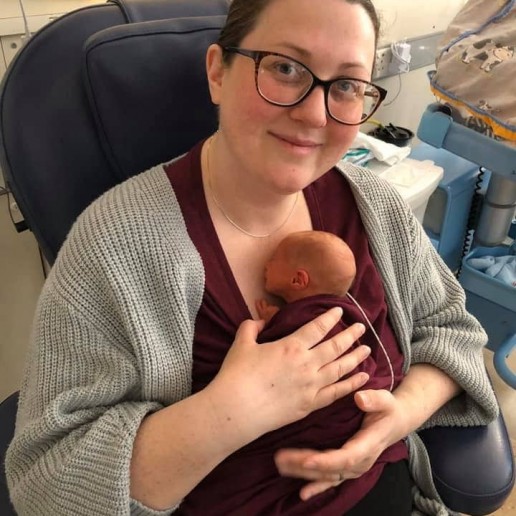
The impacts of this early contact are long lasting. Feldman et al in 2014 showed that kangaroo care “increased autonomic functioning and maternal attachment behaviour in the postpartum period, reduced maternal anxiety, and enhanced child cognitive development and executive functions from 6 months to 10 years.”
Skin to skin is clearly a fantastic thing; and the best thing about it is that the close contact in the early hours, weeks and months is normal human instinctive behaviour. It is free and effective; and should be available to all new families.
Simple wraps or specialised “kangaroo care” shirts can offer a more prolonged time skin to skin, and allow a parent/carer to move around, however it is the close contact itself, not the tool, that matters here!
What if I couldn’t do skin to skin with my child?
Not every parent/carer has the opportunity to experience skin to skin, for a wide range of reasons. This can be a source of sadness and concern, however, there are many ways to bond with your baby and help them to form secure attachments. Skin to skin is one very helpful practice, but it is not essential for relationship forming.
Your ability to bond with your baby is not determined by your birth experience, whether or not you were able to offer kangaroo care at birth or later, how you feed your child or where they sleep. It doesn’t depend on your gender or your family set-up. Relationships form by experiencing a sense of connection and love. Children learn how to love by being loved. Playing, talking, cuddling, snuggles, reading to your baby, bathing them, being responsive and present are the things that matter.
Why Carrying Matters - the benefits of babywearing
What are the benefits of babywearing? Why does carrying matter?Read more here.
Sling Fitness/Dance and Babywearing
There are many fitness or dance classes focused on maternal wellbeing and bonding with baby while babywearing, which can be a great thing to participate in, like Barre and Baby, Dance Like a Mother, Joiemove and Sling Swing, to name just some.
We all know babies thrive when close to their mothers, and baby carriers can help with this rather than putting babies down all the time. Movement and activity are known to lift the mood, and friendly, welcoming social activity is an important part of helping new parents find a supportive community so they feel less alone. So keeping babies close during a fitness or dance class may seem to be a match made in heaven… or is it?
Some classes market themselves by suggesting that new mothers should be trying to “get their body back” shortly after birth, so they feel good about themselves. I dislike this phrase; after all, why would you want to encourage a butterfly to revert to a caterpillar? Motherhood and the changes that come with it are to be celebrated. Many women would like to work on the strength and health of their bodies, but this should be a positive choice, not one made out of shame or embarrassment.
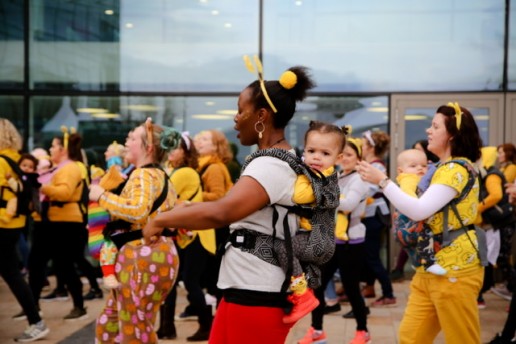
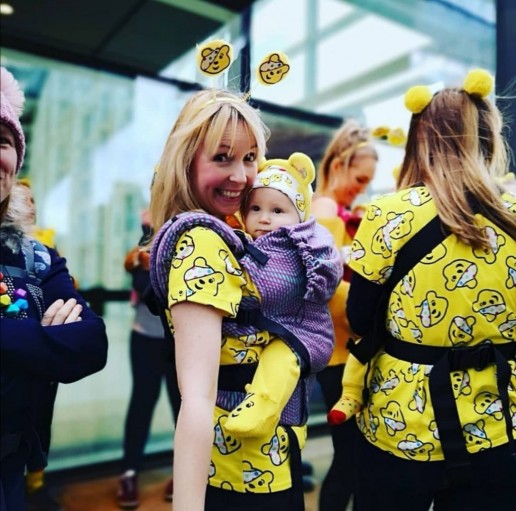
Baby safety at all times, and the health and wellbeing of new mothers are both of vital importance. It is my firmly held belief that anyone who is suggesting or recommending the use of a carrier during a class should be competent and confident in their use. This can only come with adequate training.
Furthermore, I believe that the long term health and fitness of women after birth and pregnancy takes precedence over quick-fixes. The pressure to “get your body back” and the media focus on celebrity bodies is not helpful for women. Good mental health and a supportive community are cornerstones of adapting successfully to life as a mother, and for many being active is part of that. However, there is often a significant lack of knowledge about the effects of many activities of daily life, let alone exercises or running etc on the pelvic floor, and loading it further with a baby carrier (especially one that is poorly fitting and uncomfortable) is detrimental in the early weeks to months.
It may take six months to a year for the body to recover completely, (according to research at Salford University). Of course this is very individual, depending on previous levels of health and fitness, how pregnancy and birth went, etc. Some women will be much more ready to return to their previous levels of activity than others. The “six week check” by the GP is often used as a benchmark to “sign off” as fit for exercise or dance classes. However, this is not what the six week check is for and this is not an appropriate way to establish if women are ready to return to increased levels of activity.
You can read more about my thoughts on slings and exercise here.
I believe that in order to be able to offer dance or exercise classes safely and beneficially, all instructors should be focused and committed to the health and wellbeing of both the mother and the baby as their top priority.
Instructors should all
- Have formal, high quality and officially recognised postnatal training qualifications (requiring assessment, and willing to provide these credentials to parents who ask.)
- Have a significant depth of knowledge on the pelvic floor after birth and the effects of certain movements and activity on this recovering organ. This is often lacking. I recommend the courses for fitness professionals run by Louise Field of Adore your Pelvic Floor.
- Offer proper assessment of a mother’s functional strength (beyond the “six week check”) and a willingness to adapt movements to reflect this.
- Demonstrate the ability and commitment to put the client and baby’s needs first, even if it means saying that the class isn’t suitable. Babies are not an accessory to be used for fitness.
plus
- High quality, in depth babywearing peer supporter training to ensure mothers and babies are carrying safely at all times, without any compromises. Instructors should have a particular interest in babywearing for its own sake, as opposed to something to add onto existing classes. Ideally they will already be familiar with slings. They should demonstrate a keen desire to be practising optimally and in line with current best practice. Baby and maternal safety is always paramount.
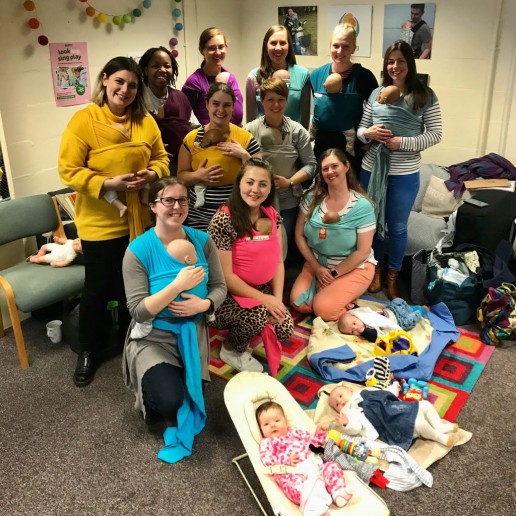
If you would like to explore the option of peer supporter training, please contact me to discuss. I reserve the right to decline training.
Please note that training with me is NOT an endorsement of any class, and Carrying Matters is NOT and never has been affiliated in any way with any fitness or dance classes.
I am no longer able to offer half day “safety awareness training” courses to those who are running postnatal fitness/dance classes. After a while running these courses, I feel this insufficient time to cover all the issues in enough depth to ensure the safety of babies and their mothers. This is especially as babywearing is not usually the main focus of the class and many class instructors have hardly any personal experience with babywearing themselves. Anyone who sees babywearing as an integral part of their class will be willing to invest in in-depth training with assessment.
Please note that I have attended a full day of training in pelvic floor awareness for fitness professionals myself.
Slings and Adoptive and Foster Families
We all know how vitally important it is for children to build secure attachments with their primary caregivers, both for a sense of security and belonging now and in the future. It is much harder for this supportive relationship to develop when the primary caregiver has difficulties of their own, and when children need to be taken into care. The adverse experiences being endured by children in these circumstances have been shown to have a long term effect on future mental and physical health
This page collects some of the most useful writing on the topic of sling use among adoptive and foster families.
Adoptive and foster parents will know that their children need all the love they can give; and a sling can play an useful part in building these bridges amidst the turmoil. The biochemistry of creating a secure attachment is not a conscious process, or one that depends on ancestry; the release of oxytocin and the down-regulation of the stress response that happens with consistent, close and loving contact happens in the background.
There are many other benefits in terms of language acquisition, socialisation, and also helping children to learn which of the adults around them are their primary caregivers.
Sue, a foster parent in the South, is a strong advocate of using slings as part of her care.
“Many of the babies who we care for have been exposed to either drugs, alcohol or domestic violence whilst in the womb. Carrying them has, without doubt, enabled them to develop into calm, sociable, happy, securely attached babies who meet (and often exceed) their developmental milestones.
Babies who have been neglected for the first few months of life can be very wary of people and situations. By carrying them they learn more about the world from a position of safety. They take cues from watching our faces and learn to trust people and situations more more quickly.
Using carriers when introducing babies to their adoptive parents show the babies that this is someone to be trusted. Only I carry the baby in a sling whilst they stay with me although many other people hold them. However from the first day of introductions the adoptive mother wears the baby in my (the baby’s) sling. I believe this shows the baby that Mummy (or Daddy) is a special person which enables the attachment to switch between us. “
“Children with disrupted attachments are often indiscriminate in who they seek to have their needs met by. Children should always be guided back to their parents by family and friends if they are approached by the child particularly for food and nurture. This process is called funnelling and is extremely important in giving a clear message to the child about who their primary caregivers are. A sling or carrier could be helpful in this process, reducing indiscriminate attachment seeking behaviour and discouraging over-enthusiastic family and friends from picking up and nurturing the child.” Carrying the Connection
This blog post from Slings and More (based in the North East) assesses the science behind how slings can help adoptive and foster parents to build secure attachments.
“Foster and adoptive families have an immense role in helping to form strong attachment bonds with the children they look after and to help those children who do not have strong attachment bonds to begin to form them.”
This is a personal account of a mother’s experience of using slings as she adopted a little girl.
Her father told her: “You two should have some time alone. She needs to learn your smell and the sound of her mama’s heart.”
Perinatal mental health challenges can be very real for adoptive parents too, and slings can be enormously helpful for all shapes and structures of family unit.
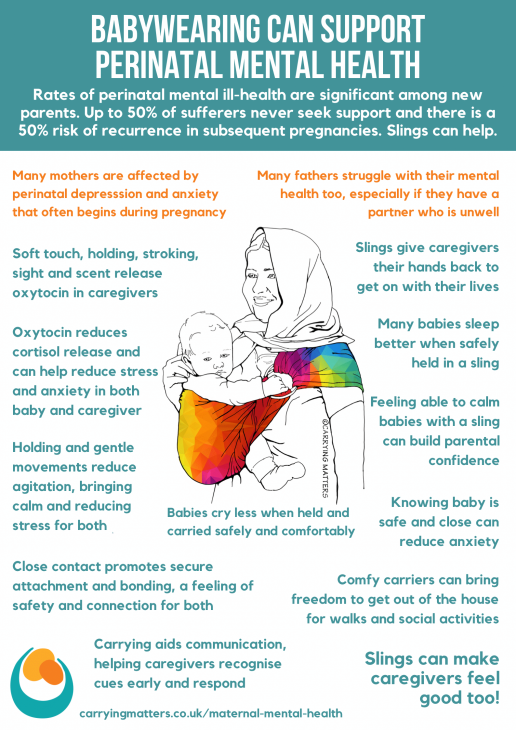
Educational Resources
This page contains various resources that may be useful for education and supporting others. Leaflets, posters and postcard packs can be purchased. Images and PDFs can be downloaded free of charge by clicking on the photos. Please ensure you credit me (Dr Rosie Knowles) if you use them.
Click on the image to download a PDF, or order a pack of high quality printed leaflets using the button below.
Click on the image to download a PDF, or order a pack of high quality printed leaflets using the button below.
Click on the image to download a PDF, or order a pack of glossy postcards or posters using the button below.
Click on the image to download a PDF, or order a pack of glossy postcards or posters using the button below.
Click on the image to download a PDF, or order a pack of glossy postcards or posters using the button below.
Click on the image below to download a PDF, or order A3 posters using the button below.
Click on the image to download a PDF, or order A3 posters using the button below.
Click on the image to download a PDF, or order A3 posters using the button below.
Click on the image to download a PDF, or order A3 posters using the button below.
Click on the image to download a PDF, or order a pack of posters using the button below.
Click on the image to download a PDF, or order a pack of posters using the button below.
Read Rosie’s well loved Why Babywearing Matters book here, published by Pinter and Martin.
Read Rosie’s well loved Why Babywearing Matters book here, translated into Polish by Lenny Lamb.
Bonding with your big kid
Bonding with your big kid is just as important as bonding with your baby. Older children need love and secure attachment relationships too, as their brains are still growing and their foundations still being laid down.
“I wish I had known about slings when I had my first child!”
“My son suddenly wants to be carried all the time suddenly and he’s so heavy now, I feel like we missed the boat.”
“My big girl is finding it hard with our new baby and seems to be much more clingy than usual. I wish I could carry her somehow..”
Do any of these comments seem familiar to you? I hear this kind of thing almost daily, and while part of me rejoices that now, at least, these parents do know how fantastic slings can be for family life, I appreciate their sadness.
But did you know, big kids like to be carried too? How many of us have hoiked our hefty toddlers onto our hips when their legs get tired of trundling along, or felt little arms wound around our necks when they are tearful? How many of our huge preschoolers still appreciate long hugs and piggyback rides? All children need closeness, long beyond the baby stage, long after they take their first steps, long after they start school… and so do grown ups! Loving contact is vital to our emotional health, from cradle to grave.

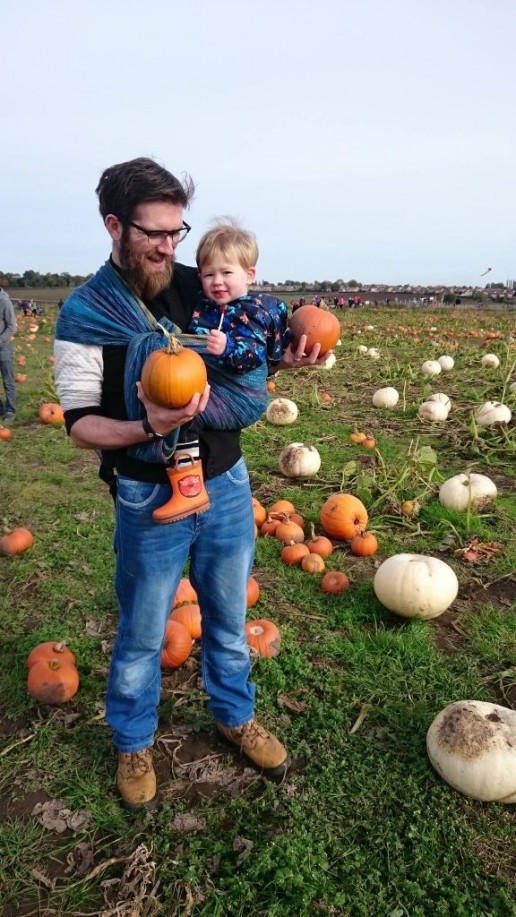
A sling is, at its most basic, a tool for enabling close contact, almost like another pair of enfolding arms around your child, while your real arms can be used for other things. A good sling, when used well, provides a feeling of all-around gentle pressure, as if being hugged all over. This can be very valuable for children struggling with sadness, with sensory overload, with tiredness, or fear from loud noises, for example. Being close to a parent’s body is reassuring and sends a valuable message to a child that “You are loved. I will look after when you are unhappy, I will keep you close when you need it. I am always here for you.” There are many other advantages to slings beyond this opportunity for connection; not least that they can be very comfortable and help to distribute the weight of a child around your body evenly, making it much easier and much less tiring than in-arms carrying. They can help to provide nourishment – breastfeeding or bottle feeding on the go, they can make school runs easier, allow greater freedom in exploration, enable naps, and keep exuberant runners out of danger in crowded areas or near roads etc.
Slings with Big Kids
You can use pretty much any kind of sling with a bigger child, even a stretchy, if it is a high quality hybrid one like the JPMBB or the Ergo wrap. I’ve helped a couple of parents with toddlers find the stretchy love, as there’s nothing quite like the enveloping gentle bounce you get with these. They do tend to work best and most easily in front carries.
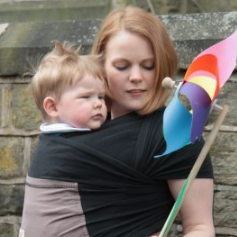
Ring slings can be fantastic, if you have the shoulder style that suits you best (pleated vs gathered), and made of a fabric that is supportive enough. People often suggest linen or hemp or silk to add strength to the softness of cotton, which indeed they do, but many 100% cottons are more than sturdy enough for heavy children, who can become easier to carry as they develop more core strength and become more compliant and easier to carry than the “bowling ball stage” – it’s worth trying a few out!
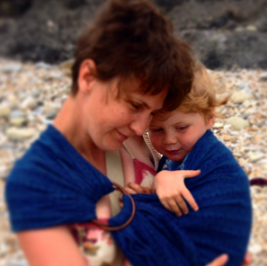
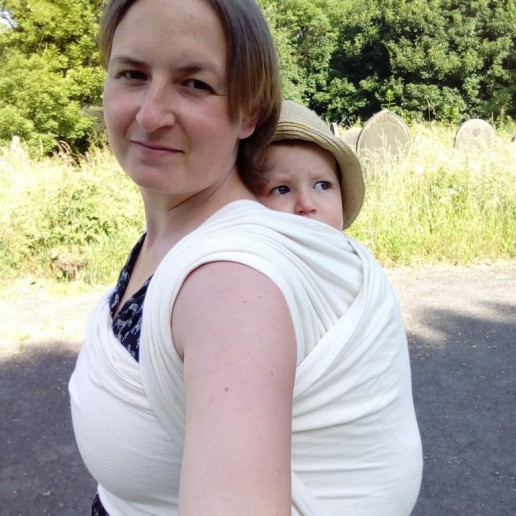
Woven wraps are the most versatile, as they can be tied in different ways, in different positions and with different levels of support. As with ring slings, the fabric used can make a difference to how a wrap feels – fibres with extra support can be helpful but may not be necessary, and as above, understanding tightening techniques and how to get a good position can really help you make the most of your current wrap
You can get toddler size meh dais, half buckles and full buckle carriers, even some up to preschool size. Again, it is worth trying a few out at your local sling library as one size does not fit all, and the body size and shape of the carrying parent plays a part too (some preschooler carriers will just be too big for petite mums, for example). Waistbands may need to be worn lower (around the hips) for front carries, and some creative methods for getting a good seat in a back carry may need to be employed! Please do take advantage of your local sling professionals about whether you need a bigger carrier for your child; it may be that your current carrier just needs a few tweaks in technique to get the most out of it. Many people upgrade to toddler carriers earlier than really necessary, and too big a carrier may be more problematic than one thats just a touch small (see my “beyond the knee to knee” article for more information).
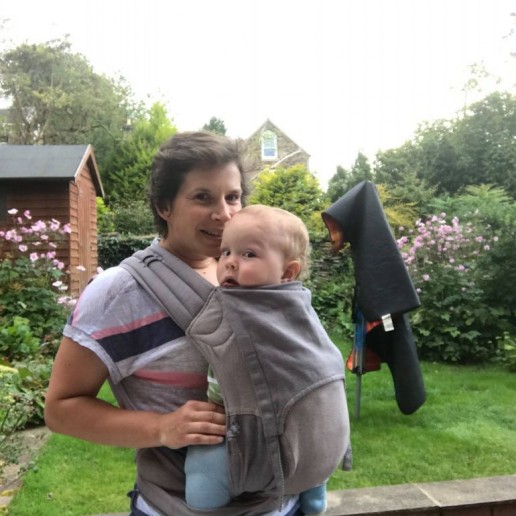
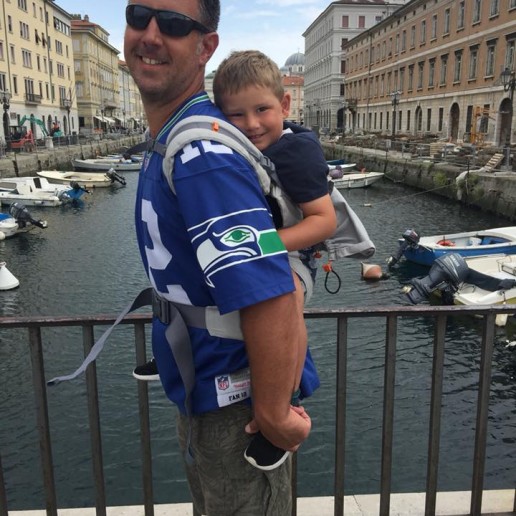
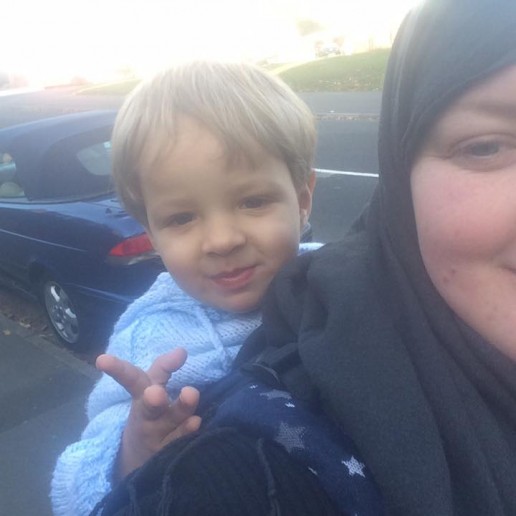
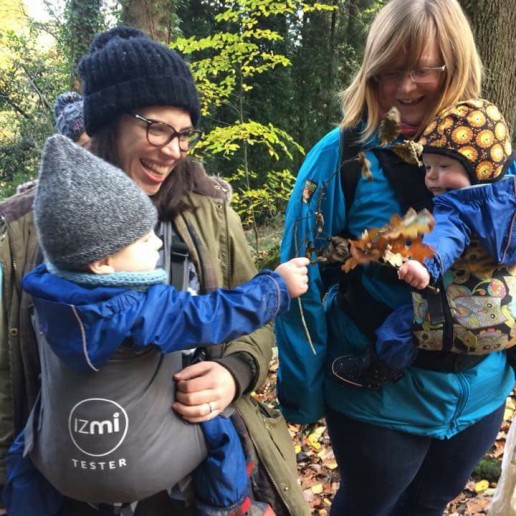
What about the inevitable comments “he’s too big to be carried like that, he should be walking!” or “You’ll just make that child clingy, you know”? Well, I think a sling is as valid a means of transport as a pushchair, and far more comfortable than achingly weary in-arms carrying. Don’t be afraid to carry your toddler – for every comment you get, you may well have planted an idea in someone else’s head. Ensure that your child doesn’t feel hurt by any comments, sometimes talking about any incidents together afterwards can be helpful. Using a sling for your bigger child from time to time will not harm them, nor will it make them babies again, any more than a hug or a hip carry would do.
My own experience
My big girl, who was nearly 4 at the time of writing, is much less often carried these days; much to my chagrin.. but she is vocal about it when she does want to be carried, climbing up me and wrapping her legs around my waist. I am happy to oblige as I’m never sure how many more carrying days we have left to enjoy. She has moods, and disappointments that the world doesn’t revolve around her, and sometimes she finds it hard to wind down. Often, at these moments, a sling has been our saviour, holding her close so she can relax, feel safe, and listen to my reassuring murmurs, while I can still get on with some of the things that just can’t wait, or save my back and arms from her lopsided weight! We use all sorts of carriers – ring slings for quick up and downs, woven wraps for sleepy cuddles, preschooler buckle carriers for rainy school runs, warm snuggly half buckles for winter walks.
Even my (then) six year old found a wrap carry a great reassurance one day when he got separated from us at the Yorkshire Sculpture Park; he was very distressed when found half an hour later and just wanted to be holding onto me. My husband’s shoulders got pretty tired after a few minutes; but I was able to carry F on my back for well over half an hour, due to the support and the weight distribution, enough time for him to feel reassured and connected again. I found it really helpful too – it was a pretty horrible forty minutes and having him in close contact was very valuable for my own feelings and allowed me to breathe and absorb, and move on.
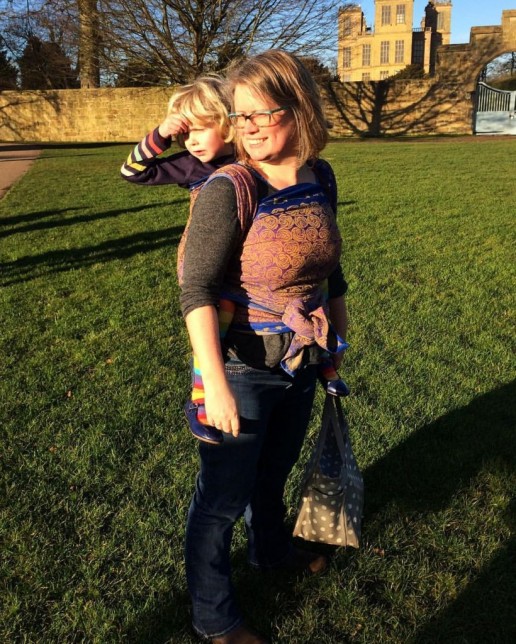
A local story of re-connecting with a sling
I’ve got to know one family with a preschooler pretty well, they hadn’t used a sling for over a year, but started again, almost from scratch. Here’s what they have to say about their experience of carrying a bigger child.
After starting nursery, H became anxious and disconnected. She chewed her fingernails to a painful point, and became difficult to communicate with, as well as regressing in toileting. Instead of adopting behavioural control techniques, I drew on my experience from other parts of our lives and adopted a regression tactic. A big part of this was returning to carrying her in a sling. We had used our high-street carrier rather than a pram on our dog walks, but had given this up over a year before as she had outgrown it. We wondered if a ring sling would be a solution for short snuggles for reconnecting. H was too heavy to attempt this from online videos, so we booked a workshop with a local sling consultant, who reassured us that she wasn’t too big, and showed us how to ensure we were all comfortable. The ring sling has been perfect for our needs and has really helped us all. More often than not, it has doubled up as a dramatic scarf for the 80% of the time H wanted to walk!
H is now almost 5. Our new buckled carrier is the perfect tool for winding down for bedtime on a camping trip, resting tired little legs whilst hiking (without the bulk of a framed carrier), and elevating her out of danger in busy, crowded areas. I really believe there is no such thing as “too big to sling!”
Slings with Two Kids
Another situation where carrying a bigger child can really help is with sibling jealousy. The other day I spoke to a family who hadn’t used their sling with their toddler for some time, and now have a new baby. Big sister has been feeling a bit jealous of the new arrival and has wanted to begin breastfeeding again. They asked for some advice, and I suggested that their daughter would really appreciate the contact that would come from using their ring sling and buckle carrier again… and so it seems to have proved. It’s not so much the desire to be a baby again, but more of a chance for communication – “you still belong to me, don’t you?”
I’m working with another lady whose older child is struggling to accept their brand new baby. She asked me to show her how to breastfeed her baby in a sling, in the hope that this would allow her to be hands free to play with her toddler. She’d never carried her first child but was loving the slings with the little one. Successful breastfeeding in a sling is a challenge that requires care to do well and safely, and in my opinion is never fully hands-free. However, one hand available can make a big difference – you can hold a book to read, help with a jigsaw at the table, stir a mixture, hold a hand, for example. Amongst other things, we looked at a ring sling, which can be used for little babies as well as bigger children who love to sit on the hip and look around, so it is a carrier that can be used for children of multiple sizes. Hopefully, carrying the bigger child from time to time while the baby is sleeping, or in a pram or carried by Dad will be helpful for dealing with big feelings and the need to know that his Mum is still Mum and will always be there to meet his needs, even with the new addition taking up so much of her time.
There are some carriers that can be used with small babies and bigger children; which means the same carrier can be used for both children when needed. The ultra- versatile ring sling and woven wraps are good examples, which mould around the parent-child dyad and can be used from birth to preschool age and beyond.
Some mei tais with adjustable width can work well for families with children born with a small age gap. The buckle-waist equivalent half-buckles can be useful, or those with wide wrap straps that can be tied in such a way that bigger children will be supported knee to knee. Some full buckle carriers can be used from birth and their panels can be adjusted to the size of the child. Some come with inbuilt adaptations for using with babies, and some have separately purchased inserts for small babies to rest on until they grow big.
Do visit your local sling library or get in touch with a sling consultant for some help navigating all these options; there will be something to suit nearly every situation!
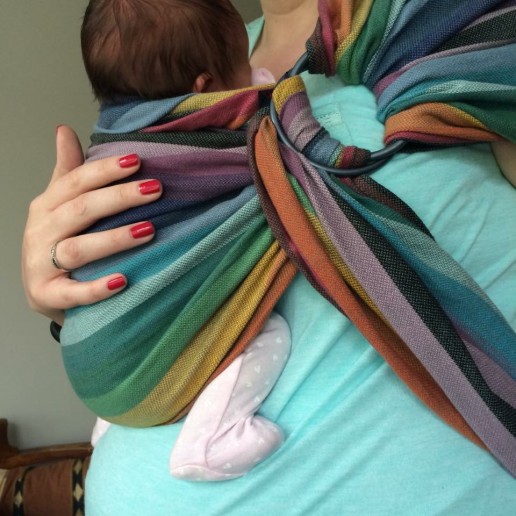
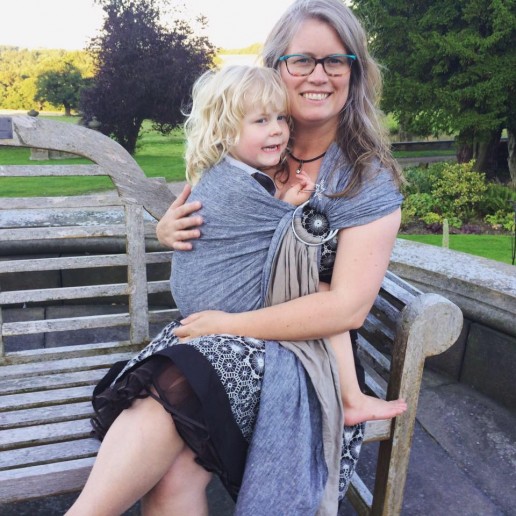
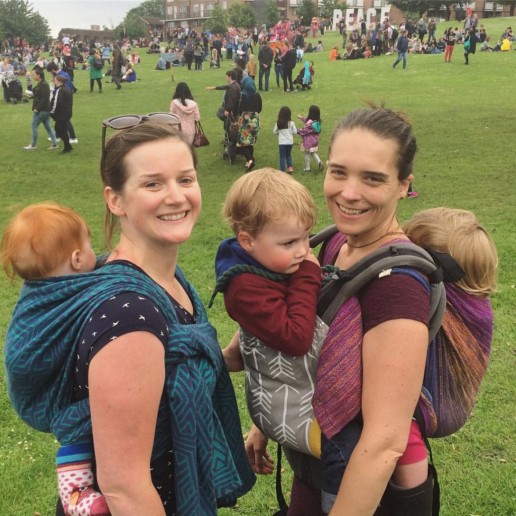
Slings during Pregnancy
During pregnancy, carrying an older child can be an opportunity to help deepen relationships and prepare for the new arrival, being reassuring that things really are going to be all right after all. Carrying while pregnant has its own challenges too; ensuring the bump isn’t compressed, that weight is well distributed, that any symphysis pubis discomfort is not exacerbated. Do see your local sling consultant or chiropractor or physio for help if you need (bearing in mind that many health care professionals may not be up to date with ergonomic, safe carriers.) There is more reading here about carrying while pregnant.
In summary, older children do not stop needing the love and support of their caregivers for a surprisingly long time. Our society seems to believe that we should encourage separation of children and caregivers as young as possible, to breed “independence”, when actually, neurophysiology suggests that children will learn independence at their own pace, as their cognitive and emotional capacities develop.
Secure Attachment and the "Fourth Trimester"
Secure attachment is the deep and enduring emotional bond that connects one person to another across time and space; a "lasting psychological connectedness between human beings" (Bowlby/Ainsworth).
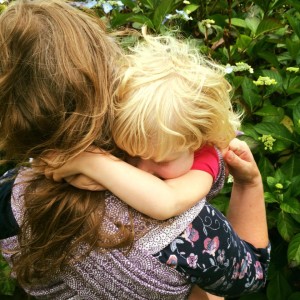
Research shows that one of the strongest predictors for insecure attachments in children is to have a parent who lacks secure attachment themselves.
So, how do you build a secure attachment relationship with your child?
Secure attachment is created by loving responsiveness to your child's needs. It is not about your parenting style. Your baby may sleep in a crib or your bed, be fed from a breast or a bottle, be held in arms or a sling, be weaned in any style, be brought up by any combination of carer and still have secure attachments. It is not about subscribing to a particular parenting philosophy. You do not have to sacrifice everything - your identity, your sanity, your relationship, your job, your money or anything else at the "altar of childhood".
Building secure attachment is about having respect for a child's personhood, building their sense of self-worth within a consistent, loving and responsible relationship, regardless of their age or understanding.
Your child's humanity is as valuable as your own; neither more nor less. You are your child's advocate in the world and their greatest defender. You can provide for their every need, and they depend entirely on you and your surrounding network. They will learn whether or not they matter from how they are treated and how their requests for support are met. Securely attached children are confident that they will be cared for, and that any distress will be met by love. They are easily soothed by their caregiver when upset, are more able to be self-reliant, form positive relationships and generally have smoother paths through life.
However, their needs need to be balanced with that of the family, as a crumbling family dynamic will ultimately not be in anyone's best interests.
The "fourth trimester" is where attachments begin to form.
What is the Fourth Trimester?
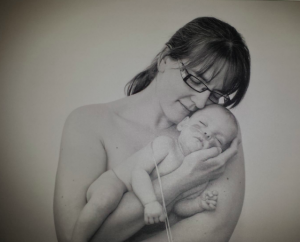
The ‘fourth trimester" is the period immediately after birth, a few more months of intense nurturing to allow a baby to continue with their essential development from a place of security and safety.
A baby who has spent all their life growing peacefully in the womb, gently compressed by uterine walls at the end of the third trimester, will find the sensation being born, followed by freedom and open space in the outside world enormously different. Limbs that have been limited are suddenly free to stretch wide, darkness has turned to light, the muffled gentle rhythmic sounds of the mother's body have been replaced by loud, unfamiliar noises or deep silence. Constant gentle motion has turned into complete stillness or sudden movements. No wonder that when babies are held close, rocked and soothed, contained in soft boundaries once more, that they settle; this feels right and familiar.
The "fourth trimester” is all about gentle transitioning from the peace and stability of the womb towards active involvement in a new world.
A newborn needs to be supported to gain skills and strength at a steady, individual pace from the security of an unshakeable foundation and place of comfort and familiarity. Being held, close to familiar noises and scents is essential to development and positive learning; the infant brain is growing rapidly and forming new connections all the time. Connections that are reinforced frequently will persist into later life, whereas those that are rarely used will wither away. It is worth taking the time to ensure that these unconsciously forming connections are positive ones. Young infants do not have the cognitive development to behave in "manipulative" ways; but they do learn to trust someone who proves reliable time and again as these pathways are reinforced. They will be startled and upset when this love is withdrawn.
The importance of responsiveness
If you are sensitive and responsive to your baby as they begin to communicate their needs with you (by crying, wriggling, yawning etc) they will learn that they matter to someone. If they are uncomfortable, the people they are learning to trust will soothe them. When they are hungry, they will be fed, when they are tired, they will feel secure enough to sink into sleep. They will not be frequently left alone unattended for long periods of time, and will not be left to exhaust themselves in calling for someone who never comes. When they cry, loving arms will be there to comfort and keep them safe. These same arms will show them the world and provide a safe place that facilitates learning. Carrying matters; babies need it. It does not make them clingy, rather, the solid foundation of secure attachment relationships will be the springboard to confident independence later in life.
How does babywearing help?
One tool that can help you meet your child's need for loving contact in these early months is a soft carrier that holds them in a comfortable, safe and anatomically respectful position. Such carriers will help you to meet their needs to be close to you while allowing you to be hands-free for daily life. There are many other positive reasons to carry a child; such as reduced crying, reduced plagiocephaly and more. Parents benefit too, for example carrying can be helpful for those with postnatal depression, and increase overall activity levels. This idea is not new; most of the world’s families across history and cultures have used some form of sling to make life work.
You can find out more from your local sling library or consultant; there are hundreds across the UK. They will help you to find the right type of carrier for your needs.
What about my older child?
Attachment relationships continue to form beyond the early months and children's brains are very "plastic". Warm, responsive, emotionally available parenting will help to build a child's sense of self-worth at any age. There is evidence that "mind-minded" parents (ie those who treat their children as intelligent, relational individuals with feelings, and speaking to them in such a way) seem to have children with more secure attachments. Active play and laughter, as well as consistent loving boundaries help to reinforce neural connections that the primary caregivers are a reliable source of security; forming strong foundations for the future. Read more about how carrying can help the learning brain.
References
Bowlby J. (1969). Attachment. Attachment and loss: Vol. 1. Loss. New York: Basic Books
Ainsworth, M. D. S. (1973). The development of infant-mother attachment. In B. Cardwell & H. Ricciuti (Eds.), Review of child development research (Vol. 3, pp. 1-94) Chicago: University of Chicago Press.
Ainsworth, M. D. S., Blehar, M. C., Waters, E., & Wall, S. (1978). Patterns of attachment: A psychological study of the strange situation. Hillsdale, NJ: Erlbaum.
Sutton Trust; Baby Bonds Parenting, attachment and a secure base for children. March 2014 Research by Sophie Moullin, Jane Waldfogel and Elizabeth Washbrook
http://www.parentingscience.com/attachment-parenting.html
Rethinking Maternal Sensitivity: Mothers’ Comments on Infants’ Mental Processes Predict Security of Attachment at 12 Months; J. Child Psychol. Psychiat. Vol. 42, No. 5, pp. 637–648, 2001


